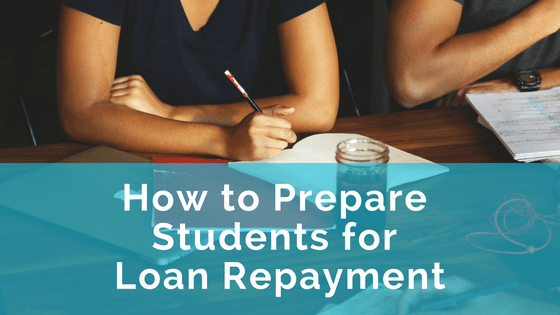According to recent reports, U.S. student loan debt is at an all-time high, totaling $1.3 trillion. It is estimated that the average Class of 2016 graduate has $37,172 in student loan debt, which is a 6% increase compared to last year.
Even more troubling, the student loan delinquency rate is 11.1% – more than double than the rate in 2003. In addition, an estimated 6.6 million students who are out of school and owe federal student loans are either in default (at least 360 days behind on payment) or delinquent (between 31 days and 360 days behind on payment) on payments.
Universities and colleges are well aware of the student loan debt problem, however, many can take a more pro-active approach in preparing students for loan repayment before they graduate. A great way to assist students and better prepare them for loan repayment after graduation is to offer a loan repayment “exit orientation”, that outlines strategies and tools to helping student pay off their loans in a timely manner.
Many universities, like UCSF, provide “toolkits” for students, offering checklists and resources to successfully paying off student debt. While this is great step in the right direction, implementing a more proactive approach like a mandatory orientation (for all students with loans on record with the Financial Aid office) can be more effective and ensure students are receiving and comprehending the information they need to pay off their debt.
If you’d like to implement a student loan exit orientation at your institution, be sure to include these 7 tips and strategies to assist your students in repaying their loan.
- Encourage students to “know their loans”.
Students should keep track of their lender, balance, and repayment status for each loan. Some loans offer a “grace period”, meaning students can postpone payment for a certain amount of time after graduation. Even if there is a grace period, students should begin researching loan details at least 6 months from graduation so that they are prepared.
For all federal loans, students can visit the National Student Loan Data System to look up loan details. If they have a private loan, they can check the most recent billing statement for contact information or consult the college’s financial aid office for any records.
For federal loans, they will most likely work with a “loan servicer” (the lender of your loans). Federal loan servicers’ contact information can be a useful resources to provide in your exit-orientation.
- Students should apply excess payments to the principal amount when possible.
Lender policies may vary, but if students make a payment that exceeds the minimum and don’t specify where the money should be applied to, the lender will decide how the student loan payment is divided up. This mean the lender may apply it to the interest instead of the principal, which will not help the original loan amount decrease. When possible, students should always choose to apply excess payments directly to the principal.
- Students should decide on a loan repayment plan and stick to it.
If a student has multiple loans, they should look at the loan amount and the interest rate for each. Encourage them to talk to their lender to determine what the best loan repayment strategy is for their budget and lifestyle. Depending on the circumstances, some may want to pay off the loans with the smallest balance first (Debt Snowball Method) or pay off the loans with the highest interest rates first (Debt Avalanche Method).
If a student has both private and federal loans, they should focus on paying off the private loans first because these loans often allow for less flexibility in repayment options.
A Debt Snowball Calculator can be a great resource to include for students.
- Remind students to check if they qualify for Loan Forgiveness.
The Public Service Loan Forgiveness Program forgives the remaining balance on Direct Loans after a student has made 120 qualifying payments under a qualifying repayment plan while working full-time for a qualifying employer.
Qualifying employers may include government organizations, not-for-profit organizations that are tax-exempt under Section 501(c)(3) and other various types of not-for-profit organizations.
While students directly out of college wouldn’t qualify (since they most likely haven’t made 120 payments), including this information can be helpful and provide “hope” to students who may think repaying their student debt seems impossible. It may influence students’ decisions as they decide on their career path after graduation.
- Provide example timelines and repayment grids to students.
UCSF provides helpful toolkit to upcoming graduates like a timeline and a repayment grid that gives repayment details on federal loans. Encourage students to download and print these resources so they can reference them after graduation when they may no longer have access to your institutions’ internal portal. These timelines can help students visualize their plan after graduate and help them to stick to their repayment strategy if they can see an end goal is attainable.
- Remind students to consider refinancing options if needed.
Students with strong credit and a consistent income may qualify for refinancing. Refinancing allows students to replace one or more loans with a new, lower-rate loan to save money.
Offer a student loan refinancing calculator so students can determine how much they would save. While they many not be thinking about refinancing directly out of college, its good to make them aware of this option from the start so that they can determine if this can be a potential strategy further down the road.
- Help students create a budget to reduce stress and ensure payments.
By creating a monthly budget that factors in student loan payments, students can ensure they are always able to meet their monthly payment. Many students find it useful to pay off their monthly payment at the start of the month (or when you paycheck is released) instead of at the end when they money have already be spent.
Remind students to consider using unexpected bonuses or tax refunds to pay off a chunk of their loan (in addition to the monthly payment). While it can be tempting to spend the money elsewhere, this unexpected income wasn’t originally in their budget, so it’s a great to way knock down the loan amount.
Customizing your Exit-Orientation
Just like your new student and transfer student orientation, your student loan exit-orientation should be customized to your institution. Research the data for your institution on what type of loans your students have, monthly payment statistics, and default rates to determine what information would be most useful.
New student orientations have been proven to be extremely useful in preparing students for higher education and improving retention rates. By applying this same strategy to student loan repayment, we feel students will be better prepared and able to manage their student debt.






